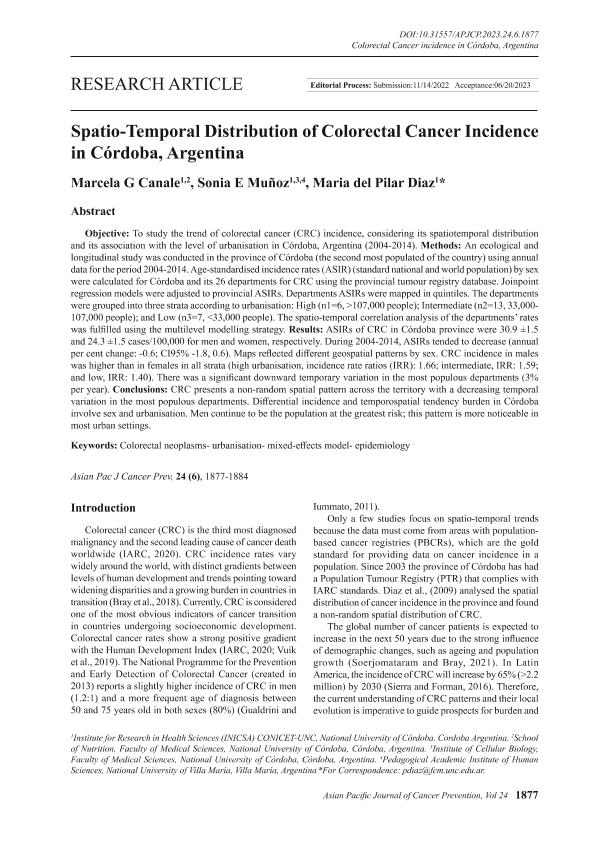Artículo
Spatio-Temporal Distribution of Colorectal Cancer Incidence in Córdoba, Argentina
Fecha de publicación:
06/2023
Editorial:
Asian Pacific Organization Cancer Prevention
Revista:
Asian Pacific Journal of Cancer Prevention
e-ISSN:
2476-762X
Idioma:
Inglés
Tipo de recurso:
Artículo publicado
Clasificación temática:
Resumen
Objective: To study the trend of colorectal cancer (CRC) incidence, considering its spatiotemporal distribution and its association with the level of urbanisation in Córdoba, Argentina (2004-2014). Methods: An ecological and longitudinal study was conducted in the province of Córdoba (the second most populated of the country) using annual data for the period 2004-2014. Age-standardised incidence rates (ASIR) (standard national and world population) by sex were calculated for Córdoba and its 26 departments for CRC using the provincial tumour registry database. Joinpoint regression models were adjusted to provincial ASIRs. Departments ASIRs were mapped in quintiles. The departments were grouped into three strata according to urbanisation: High (n1=6, >107,000 people); Intermediate (n2=13, 33,000-107,000 people); and Low (n3=7, <33,000 people). The spatio-temporal correlation analysis of the departments’ rates was fulfilled using the multilevel modelling strategy. Results: ASIRs of CRC in Córdoba province were 30.9 ±1.5 and 24.3 ±1.5 cases/100,000 for men and women, respectively. During 2004-2014, ASIRs tended to decrease (annual per cent change: -0.6; CI95% -1.8, 0.6). Maps reflected different geospatial patterns by sex. CRC incidence in males was higher than in females in all strata (high urbanisation, incidence rate ratios (IRR): 1.66; intermediate, IRR: 1.59; and low, IRR: 1.40). There was a significant downward temporary variation in the most populous departments (3% per year). Conclusions: CRC presents a non-random spatial pattern across the territory with a decreasing temporal variation in the most populous departments. Differential incidence and temporospatial tendency burden in Córdoba involve sex and urbanisation. Men continue to be the population at the greatest risk; this pattern is more noticeable in most urban settings.
Palabras clave:
COLORECTAL NEOPLASMS
,
EFFECTS MODEL
,
EPIDEMIOLOGY
,
MIXED
,
URBANISATION
Archivos asociados
Licencia
Identificadores
Colecciones
Articulos(INICSA)
Articulos de INSTITUTO DE INVESTIGACIONES EN CIENCIAS DE LA SALUD
Articulos de INSTITUTO DE INVESTIGACIONES EN CIENCIAS DE LA SALUD
Citación
Canale, Marcela Guadalupe; Muñoz, Sonia Edith; Diaz, Maria del Pilar; Spatio-Temporal Distribution of Colorectal Cancer Incidence in Córdoba, Argentina; Asian Pacific Organization Cancer Prevention; Asian Pacific Journal of Cancer Prevention; 24; 6; 6-2023; 1877-1884
Compartir
Altmétricas




